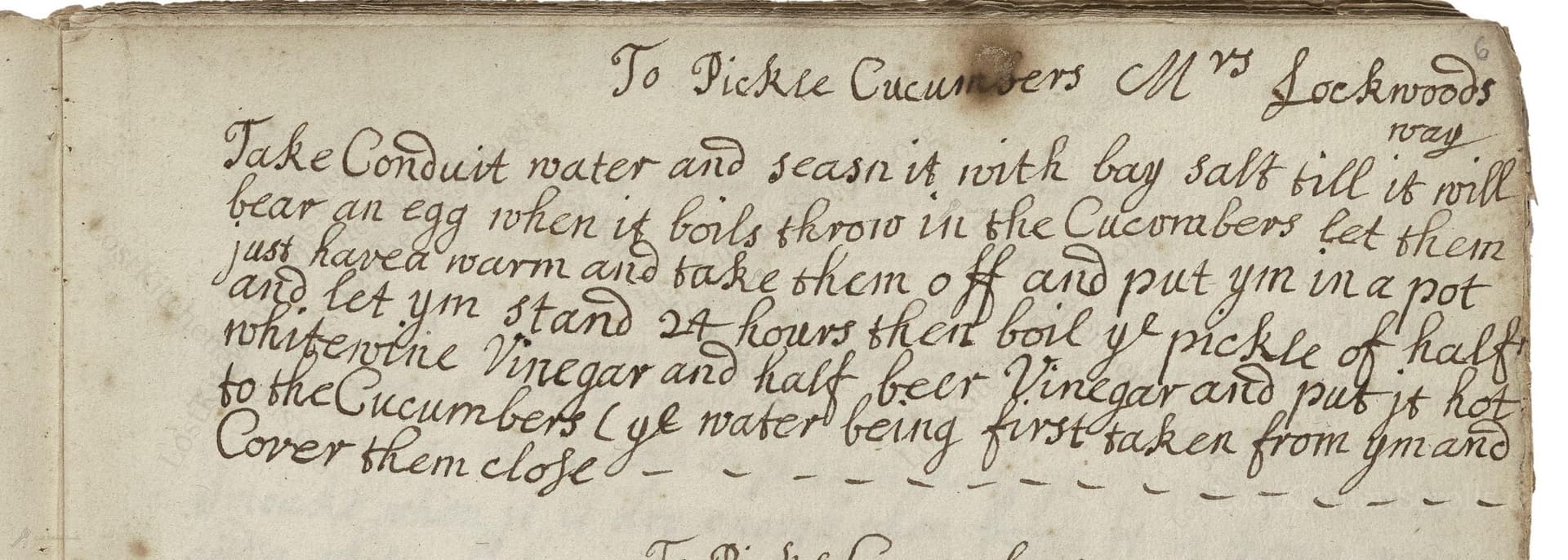To Pickle Cucumbers Mrs Lockwoods Way
From the treasured pages of Cookbook of Mary Cruso and Timothy Cruso
Written by Mary Cruso

To Pickle Cucumbers Mrs Lockwoods Way
"Take Conduit water and seasn it with bay salt till it will bear an egg when it boils throw in the Cucumbers let them just have a warm and take them off and put ym in a pot and let ym stand 24 hours then boil ye pickle of half white vine Vinegar and half beer vinegar and put it hot to the Cucumbers (ye water being first taken from ym) and Cover them close --"
Note on the Original Text
The original recipe was written in a compact, continuous style, as was common for household receipt books in the 17th century—little punctuation and few standardized measures. Spelling was fluid ('ym' for 'them', 'ye' for 'the', 'vine Vinegar' for 'wine vinegar'), and abbreviations pepper the text. Directions were implied by the order of the sentences, relying on the reader’s practical kitchen knowledge. The recipe is instructive but assumes an experienced cook will fill in the gaps. This was typical for its era, where recipes served as memory aids rather than step-by-step guides.

Title
Cookbook of Mary Cruso and Timothy Cruso (1689)
You can also click the book image above to peruse the original tome
Writer
Mary Cruso
Era
1689
Publisher
Unknown
Background
Step into the flavorful world of 17th-century cuisine with Mary Cruso’s delightful collection, where time-honored recipes and inventive cookery tips offer a peek at the tastes and talents of yesteryear’s domestic kitchens.
Kindly made available by
Folger Shakespeare Library
This recipe hails from late 17th-century England (1689) and was recorded by Mary Cruso. During this era, pickling was an essential method for preserving harvests, and households took great pride in their unique approaches to common preserves. Mrs. Lockwood's method reflects this tradition, blending salt and vinegar to keep cucumbers crisp through the seasons. The use of both white wine vinegar and beer (malt) vinegar hints at the varied flavors and resources available to well-stocked kitchens of the time. Preserving vegetables in brine and vinegar was central to English cookery, particularly among wealthier households who had access to imported wines and vinegars, as well as dedicated kitchen help to manage the labor of preservation.

In the late 1600s, the process would have utilized large earthenware or stoneware pots for soaking and storing, and perhaps pewter or wooden spoons for stirring. The brine and vinegar would be heated in heavy copper or iron kettles over an open hearth or coal fire. Fine straining cloths or simple ladles would be used to transfer liquids, and a closely-fitted wooden or stone lid would seal the pot. Hands-on attention to temperature and timing was essential, as there were no thermometers. A floating egg was the classic method for gauging the salinity of the brine.
Prep Time
10 mins
Cook Time
2 mins
Servings
5
We've done our best to adapt this historical recipe for modern kitchens, but some details may still need refinement. We warmly welcome feedback from fellow cooks and culinary historians — your insights support the entire community!
Ingredients
- 1 quart filtered water
- 3.5 ounces coarse sea salt (bay salt or substitute with best-quality sea salt)
- 1 pound small, firm cucumbers (gherkins are ideal)
- 1 cup white wine vinegar
- 1 cup malt vinegar (beer vinegar; substitute with malt vinegar if beer vinegar unavailable)
Instructions
- Begin by taking about 1 quart of clean, filtered water - traditionally called 'conduit water' - and season it generously with bay salt, or coarse sea salt, until the brine is so salty that a fresh egg will float on its surface (about 3.5 ounces of salt per quart of water).
- Bring this brine to a boil.
- Once boiling, add the whole small cucumbers (about 1 pound), let them warm in the brine for just a minute or two, then remove them with a slotted spoon.
- Place the warmed cucumbers into a clean jar or ceramic pot, and let them sit at room temperature for 24 hours.
- Next, prepare your pickling vinegar by combining equal parts of white wine vinegar and malt vinegar (about 1 cup each), and bring the mixture to a boil.
- Pour off the brine from the cucumbers, then pour the hot vinegar mixture over the drained cucumbers so they are fully covered.
- Seal the jar tightly, and allow the pickles to cool before storing.
Estimated Calories
22 per serving
Cooking Estimates
You will spend a few minutes preparing the ingredients and making the brine. The actual cooking, which is briefly boiling the cucumbers, takes just 2 minutes. Most of the time is passive, waiting for the cucumbers to soak.
As noted above, we have made our best effort to translate and adapt this historical recipe for modern kitchens, taking into account ingredients nowadays, cooking techniques, measurements, and so on. However, historical recipes often contain assumptions that require interpretation.
We'd love for anyone to help improve these adaptations. Community contributions are highly welcome. If you have suggestions, corrections, or cooking tips based on your experience with this recipe, please share them below.
Join the Discussion
Rate This Recipe
Dietary Preference
Main Ingredients
Culinary Technique

Den Bockfisch In Einer Fleisch Suppen Zu Kochen
This recipe hails from a German manuscript cookbook compiled in 1696, a time whe...

Die Grieß Nudlen Zumachen
This recipe comes from a rather mysterious manuscript cookbook, penned anonymous...

Ein Boudain
This recipe comes from an anonymous German-language manuscript cookbook from 169...

Ein Gesaltzen Citroni
This recipe, dating from 1696, comes from an extensive anonymous German cookbook...
Browse our complete collection of time-honored recipes



